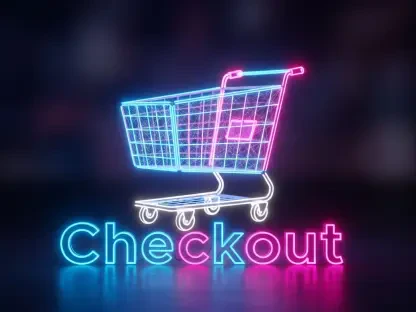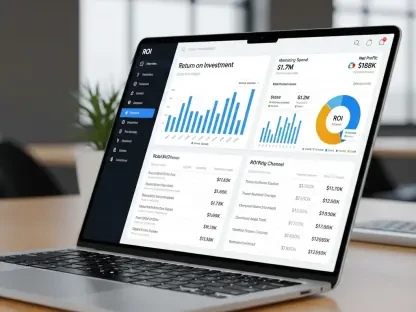The retail industry is undergoing a profound transformation, driven by the integration of Internet of Things (IoT) technologies. These advancements are reshaping various facets of the retail landscape, from inventory management and customer experience to security and loss prevention. By leveraging IoT devices such as smart sensors and real-time analytics, retailers are enhancing operational efficiencies and revolutionizing customer engagement. This article delves into the top nine applications of IoT in the retail sector, exploring how these technologies are revolutionizing shopping.
Enhancing Inventory Management
Retailers are increasingly using IoT to improve demand forecasting and mitigate supply chain inefficiencies. IoT-enabled devices such as RFID tags and connected sensors provide real-time visibility into operations, streamlining warehouse operations and inventory replenishment. Smart shelves automatically monitor inventory levels, ensuring timely restocking and reducing the risk of stockouts. Real-time inventory tracking systems allow retailers to maintain accurate inventory records, reducing discrepancies and improving order fulfillment efficiency. Dynamic pricing algorithms, powered by IoT, adjust prices in response to supply and demand, optimizing sales and profitability. These technologies collectively enhance inventory management, reducing costs and improving customer satisfaction. With accurate, up-to-the-minute information on stock levels, retailers can avoid overstocking or understocking, leading to better customer service and increased sales.
Moreover, IoT in inventory management helps in automating the reordering process; by integrating IoT with enterprise resource planning (ERP) systems, retailers can automate purchase orders when stock levels drop below a certain threshold. This ensures continuous product availability and reduces the chance of lost sales due to out-of-stock situations. The overall effect is a seamless inventory management process with minimized human errors and maximized operational efficiency.
Optimizing Supply Chain Operations
IoT plays a crucial role in supply chain optimization by tracking and monitoring goods throughout the transit process. Real-time data on location, temperature, and condition of goods ensure that products reach their destinations on time and in proper condition. This is particularly important for perishable goods, where cold chain monitoring ensures product integrity and reduces spoilage. Product authenticity and traceability systems, enabled by IoT, provide transparency and build consumer trust. Automated pallets and warehouse optimization technologies streamline logistics, reducing manual labor and improving efficiency. These advancements in supply chain operations lead to cost savings and enhanced reliability. By using IoT devices, retailers can monitor the entire supply chain in real time, from production to delivery, allowing for immediate action if any issues arise.
In addition, IoT facilitates precise delivery scheduling and route optimization for freight carriers. By analyzing real-time traffic data and other variables, IoT systems can determine the most efficient delivery routes, reducing delays and fuel costs. This improves overall supply chain efficiency and ensures that products are delivered to stores or directly to customers more quickly and reliably. The end result is a leaner, more responsive supply chain that can better meet the demands of a rapidly changing retail environment.
Revolutionizing Customer Experience
IoT technologies are transforming customer experience management by offering personalized and interactive shopping environments. Self-service kiosks and smart fitting rooms reduce customer waiting times and provide tailored shopping experiences. Personalized product recommendations, based on data collected from IoT devices, enhance customer satisfaction and drive sales. Smart price tags and in-store traffic analysis optimize store layouts, making shopping more convenient and enjoyable. These technologies enable retailers to understand customer preferences and behaviors, allowing for targeted promotions and dynamic pricing strategies. The result is a more engaging and satisfying shopping experience. By leveraging IoT, retailers can gather detailed insights into customer journeys, helping them understand how shoppers move through the store and which displays catch their attention.
Moreover, IoT-driven augmented reality (AR) and virtual reality (VR) applications are enhancing the in-store experience. These technologies allow customers to visualize products in different environments or try on clothes virtually, making the shopping experience more interactive and immersive. This not only increases the likelihood of a purchase but also creates a memorable experience that can drive customer loyalty and repeat visits.
Strengthening Security and Loss Prevention
Security and loss prevention are critical areas where IoT technologies make a significant impact. Facial recognition systems and RFID-based anti-theft technologies provide real-time alerts for suspicious behavior, reducing theft incidents. Smart surveillance systems monitor employee movements, preventing internal theft and ensuring a safe shopping environment. These IoT-powered security measures not only protect assets but also enhance the overall shopping experience by providing a secure environment for customers and employees. Retailers can focus on delivering exceptional service without the constant worry of security breaches. In addition, IoT devices can monitor inventory levels and automatically alert store managers if there are discrepancies, helping to quickly identify and address potential theft or loss issues.
The integration of IoT in security systems also enables remote monitoring and control. Store managers can receive real-time updates and control security systems from anywhere, making it easier to manage multiple locations. This level of control and visibility ensures that security measures are always in place and any issues can be swiftly addressed, minimizing losses and protecting the retail business’s bottom line.
Improving Energy Management
Energy management is another area where IoT technologies offer substantial benefits. Connected sensors monitor temperature, humidity, and energy usage in real-time, optimizing HVAC systems and lighting. Predictive analytics identify energy inefficiencies, allowing retailers to take corrective actions and reduce energy consumption. These IoT-enabled energy management systems not only lower operational costs but also promote sustainability. By reducing energy waste and improving efficiency, retailers can contribute to eco-friendly practices and enhance their corporate social responsibility. Retail stores can significantly reduce their carbon footprint and operational expenses by implementing energy-saving measures based on IoT data.
Furthermore, IoT allows for automated energy optimization, such as adjusting heating, cooling, and lighting based on real-time occupancy and usage patterns. This dynamic approach ensures that energy is used only when needed, reducing wastage and improving overall efficiency. By leveraging IoT technologies for energy management, retailers can create a more sustainable and cost-effective operation while positioning themselves as environmentally responsible brands.
Streamlining In-Store Navigation
Large retail stores can be overwhelming for customers, but IoT technologies simplify in-store navigation. Beacon-based navigation systems and interactive maps guide customers to their desired products quickly, reducing shopping time and enhancing convenience. Emergency response systems ensure customer safety by providing real-time alerts and guidance during emergencies. These navigation technologies improve the overall shopping experience by making it easier for customers to find what they need. Retailers can also use the data collected from these systems to optimize store layouts and improve traffic flow. This results in a more organized and enjoyable shopping environment, reducing frustration and enhancing customer satisfaction.
In addition to improving customer navigation, IoT can help retailers analyze in-store traffic patterns. By understanding how customers move through the store and interact with different displays, retailers can optimize product placement and store layouts to increase sales. This data-driven approach ensures that products are placed where they are most likely to attract attention and drive purchases, maximizing the retail space’s effectiveness.
Enabling Automated Checkouts
Automated checkouts are becoming increasingly popular, thanks to IoT technologies. Connected cameras, sensors, and item recognition scales enable self-checkout kiosks and smart shopping carts, reducing wait times and streamlining the checkout process. RFID-enabled checkouts further enhance efficiency by allowing customers to complete transactions quickly and effortlessly. These automated systems not only improve customer satisfaction but also reduce labor costs for retailers. By minimizing the need for manual checkout processes, retailers can allocate resources more effectively and focus on enhancing other aspects of the shopping experience. Additionally, automated checkout systems can handle a higher volume of transactions, reducing bottlenecks during peak shopping times and ensuring a smoother checkout process for customers.
Furthermore, IoT-powered automated checkouts can offer personalized promotions and discounts based on customer purchase history and preferences. By integrating loyalty programs with IoT systems, retailers can reward frequent shoppers and encourage repeat visits. This personalized approach to customer engagement can drive sales and build long-term customer loyalty, providing a competitive edge in the retail market.
Empowering Mobile Payment Solutions
IoT technologies are revolutionizing payment solutions by enabling contactless transactions, biometric payments, and location-based payments. These mobile payment systems enhance security and convenience, offering faster, hands-free transactions. Customers can enjoy a seamless payment experience, reducing the time spent at checkout. The integration of IoT in payment solutions also provides retailers with valuable data on customer spending patterns and preferences. This information can be used to develop targeted marketing strategies and personalized promotions, further enhancing customer engagement and loyalty. By offering a variety of secure and convenient payment options, retailers can cater to the diverse preferences of their customers and improve overall satisfaction.
In addition, IoT in mobile payment solutions can support innovative payment methods such as digital wallets and cryptocurrency. As these technologies continue to evolve, retailers can stay ahead of trends and offer cutting-edge payment options that appeal to tech-savvy consumers. Embracing IoT in payment solutions ensures that retailers remain competitive and meet the growing demand for seamless, secure, and versatile payment experiences.
Monitoring Customer Behavior
Retailers are leveraging IoT devices to gain deeper insights into customer behavior and preferences. IoT-enabled cameras, sensors, and beacons track customer movements and interactions within the store, providing valuable data on shopping patterns. This data helps retailers understand customer preferences and optimize store layouts, product placements, and marketing strategies. By analyzing customer behavior, retailers can create more personalized shopping experiences and tailor their offerings to meet individual needs.
In addition, IoT devices can capture data on customer dwell times, the duration spent browsing specific products, and responses to different displays. By understanding these nuances, retailers can develop targeted promotions and adjust merchandising strategies to maximize customer engagement and sales. IoT also facilitates real-time feedback mechanisms, allowing stores to make immediate adjustments based on customer interactions.
Moreover, retailers can integrate IoT data with customer relationship management (CRM) systems to create holistic customer profiles. This enables more precise segmentation and personalized marketing efforts. By leveraging IoT to monitor and analyze customer behavior, retailers gain actionable insights that drive sales, enhance customer satisfaction, and foster long-term loyalty.
By embracing IoT, retailers are not just keeping up with the times—they’re setting new standards in the industry. This article explores the top nine ways IoT is making waves in retail, demonstrating the transformative power of this technology in modern shopping experiences.









